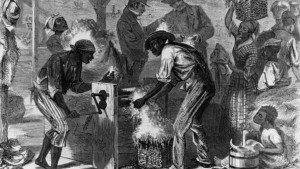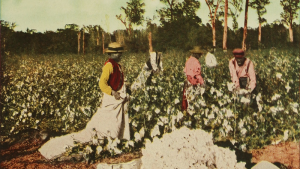The Cotton Economy and Slavery
What made cotton so desirable? In the 1790s Americas oldest crops, like tobacco, were depleting farmland and dropping in value. At the same time, the textile industry in Great Britain was exploding, creating enormous international demand for cotton clothing. Eli Whitney’s invention of the cotton gin, which easily separated cotton fiber from its seeds, was merely a motor for a global economic machine. Slavery was its fuel.
Many stakeholders benefited from the cotton economy — plantation owners in the South, banks in the North, shipping merchants, and the textile industry in Great Britain. Cotton transformed the United States, making fertile land in the Deep South, from Georgia to Texas, extraordinarily valuable. Growing more cotton meant an increased demand for slaves. Slaves in the Upper South became incredibly more valuable as commodities because of this demand for them in the Deep South. They were sold off in droves. This created a Second Middle Passage, the second largest forced migration in America’s history.
To feed “King Cotton,” more than a million African Americans were carried off into the Deep South. That’s two and a half times the number that were brought to the United States from Africa.
To learn more about the connection of cotton and slavery, tune in to PBS on October 29, 2013, 8-9 pm ET, for the premiere of episode two of The African Americans: Many Rivers to Cross with Henry Louis Gates, Jr. Check the local listings on the broadcast schedule.
What made cotton so desirable? In the 1790s Americas oldest crops, like tobacco, were depleting farmland and dropping in value. At the same time, the textile industry in Great Britain was exploding, creating enormous international demand for cotton clothing. Eli Whitney’s invention of the cotton gin, which easily separated cotton fiber from its seeds, was merely a motor for a global economic machine. Slavery was its fuel.
Many stakeholders benefited from the cotton economy — plantation owners in the South, banks in the North, shipping merchants, and the textile industry in Great Britain. Cotton transformed the United States, making fertile land in the Deep South, from Georgia to Texas, extraordinarily valuable. Growing more cotton meant an increased demand for slaves. Slaves in the Upper South became incredibly more valuable as commodities because of this demand for them in the Deep South. They were sold off in droves. This created a Second Middle Passage, the second largest forced migration in America’s history.
To feed “King Cotton,” more than a million African Americans were carried off into the Deep South. That’s two and a half times the number that were brought to the United States from Africa.
To learn more about the connection of cotton and slavery, tune in to PBS on October 29, 2013, 8-9 pm ET, for the premiere of episode two of The African Americans: Many Rivers to Cross with Henry Louis Gates, Jr. Check the local listings on the broadcast schedule.
Find educational resources related to this program - and access to thousands of curriculum-targeted digital resources for the classroom at PBS LearningMedia.
Visit PBS Learning Media








